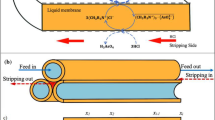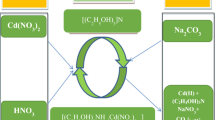Abstract
In this article, we report the efficient removal of arsenic in the form of arsenite (As(III)) from an aqueous solution which was applied on the industrial effluents. A flat-sheet polypropylene-supported liquid membrane (SLM) was clamped between the feed phase and strip phase in a liquid membrane permeator setup using tridodecylamine (TDDA) as carrier for extraction of As(III). We have optimized the reaction in changing different parameters such as metal, acid concentration in feed phase, strip phase concentration, and carrier concentration for the maximum As(III) transport through the SLM. The flux value, time of extraction, the stoichiometry of the complex formed, and membrane stability were also investigated. As a result of different experiments performed, we find the best conditions of 0.1 mol/L of TDDA, 1.0 mol/L of HCl in feed phase at optimum pH 1, and 1.0 mol/L of NaOH in stripping phase for the maximum As(III) removal. The optimized reaction was utilized on effluent collected from different industries. During repeated set of experiments on a single polypropylene membrane, it was found that it could withstand five consecutive experiments. Moreover, as high as 93% of extraction efficiency was achieved in 180 min.










Similar content being viewed by others
References
Ali K, Nawaz R, Ali N, Khaliq A, Ullah R (2015) Selective removal of zinc using tri-ethanolamine-based supported liquid membrane. Desalin Water Treat 57:8549–8560
Amini M, Rahbar-Kelishami A, Alipour M, Vahidi O (2018) Supported liquid membrane in metal ion separation: an overview. J Membr Sci Res 4:121–135
Ansari SA, Mohapatra PK, Manchanda VK (2009) Recovery of actinides and lanthanides from high-level waste using hollow-fiber supported liquid membrane with TODGA as the carrier. Ind Eng Chem Res 48:8605–8612
Bey S, Semghouni H, Criscuoli A, Benamor M, Drioli E, Figoli A (2018) Extraction kinetics of As (V) by Aliquat-336 using asymmetric PVDF hollow-fiber membrane contactors. Membranes 8:53
Bhattacharya P, Welch AH, Stollenwerk KG, McLaughlin MJ, Bundschuh J, Panaullah G (2007) Arsenic in the environment: biology and chemistry. Sci Total Environ 379:109–120
Choong TSY, Chuah TG, Robiah Y, Gregory Koay FL, Azni I (2007) Arsenic toxicity, health hazards and removal techniques from water: an overview. Desalination 217:139–166
Elwakeel KZ (2009) Removal of As(V) from aqueous solution using glycidyl methacrylate resin immobilized with Cu(II)-tetraethylenepentamine complex. Water Sci Technol Water Supply 9:181–190
Elwakeel KZ (2014) Removal of arsenate from aqueous media by magnetic chitosan resin immobilized with molybdate oxoanions. Int J Environ Sci Technol 11:1051–1062
Elwakeel KZ, Al-Bogami AS (2018) Influence of Mo(VI) immobilization and temperature on As(V) sorption onto magnetic separable poly p-phenylenediamine-thiourea-formaldehyde condensate. J Hazard Mater 342:335–346
Gu K, Li W, Han J, Liu W, Qin W, Cai L (2019) Arsenic removal from lead-zinc smelter ash by NaOH-H2O2 leaching. Sep Purif Technol 209:128–135
Güell R, Fontàs C, Anticó E, Salvadó V, Crespo JG, Velizarov S (2011) Transport and separation of arsenate and arsenite from aqueous media by supported liquid and anion-exchange membranes. Sep Purif Technol 80:428–434
Hao L, Wang N, Wang C, Li G (2018) Arsenic removal from water and river water by the combined adsorption-UF membrane process. Chemosphere 202:768–776
Hernández-Flores H, Pariona N, Herrera-Trejo M, Hdz-García HM, Mtz-Enriquez AI (2018) Concrete/maghemite nanocomposites as novel adsorbents for arsenic removal. J Mol Struct
Ho WW (2003) Removal and recovery of metals and other materials by supported liquid membranes with strip dispersion. Ann N Y Acad Sci 984:97–122
Jain C, Ali I (2000) Arsenic: occurrence, toxicity and speciation techniques. Water Res 34:4304–4312
Jiang JQ, Ashekuzzaman SM, Jiang A, Sharifuzzaman SM, Chowdhury SR (2012) Arsenic contaminated groundwater and its treatment options in Bangladesh. Int J Environ Res Public Health 10:18–46
Lothongkum AW, Suren S, Chaturabul S, Thamphiphit N, Pancharoen U (2011) Simultaneous removal of arsenic and mercury from natural-gas-co-produced water from the Gulf of Thailand using synergistic extractant via HFSLM. J Membr Sci 369:350–358
Mandal BK, Suzuki KT (2002) Arsenic round the world: a review. Talanta 58:201–235
Marino T, Figoli A (2015) Arsenic removal by liquid membranes. Membranes 5:150–167
Matschullat J (2000) Arsenic in the geosphere—a review. Sci Total Environ 249:297–312
Narayana B, Cherian T, Mathew M, Pasha C (2006) Spectrophotometric determination of arsenic in environmental and biological samples. Indian J Chem Technol 13:36–40
Nawaz R, Ali K, Ali N, Khaliq A (2015) Removal of chromium(VI) from industrial effluents through supported liquid membrane using trioctylphosphine oxide as a carrier. J Braz Chem Soc
Ng JC, Wang J, Shraim A (2003) A global health problem caused by arsenic from natural sources. Chemosphere 52:1353–1359
Ong YT, Yee KF, Cheng YK, Tan SH (2014) A review on the use and stability of supported liquid membranes in the pervaporation process. Sep Purif Rev 43:62–88
Pancharoen U, Poonkum W, Lothongkum AW (2009) Treatment of arsenic ions from produced water through hollow fiber supported liquid membrane. J Alloys Compd 482:328–334
Perez M, Reyes-Aguilera J, Saucedo T, Gonzalez M, Navarro R, Avila-Rodriguez M (2007) Study of As(V) transfer through a supported liquid membrane impregnated with trioctylphosphine oxide (Cyanex 921). J Membr Sci 302:119–126
Prapasawat T, Ramakul P, Satayaprasert C, Pancharoen U, Lothongkum AW (2008) Separation of As (III) and As (V) by hollow fiber supported liquid membrane based on the mass transfer theory. Korean J Chem Eng 25:158–163
Prum C, Dolphen R, Thiravetyan P (2018) Enhancing arsenic removal from arsenic-contaminated water by Echinodorus cordifolius−endophytic Arthrobacter creatinolyticus interactions. J Environ Manag 213:11–19
Rehman S, Akhtar G, Chaudry MA, Bukhari N, Najeebullah AN (2011) Mn (VII) ions transport by triethanolamine cyclohexanone based supported liquid membrane and recovery of Mn (II) ions from discharged zinc carbon dry battery cell. J Membr Sci 366:125–131
Rehman UH, Akhtar G, Ur Rashid H, Ali N, Ahmad I et al (2017) Transport of Zn (II) by TDDA-polypropylene supported liquid membranes and recovery from waste discharge liquor of galvanizing plant of Zn (II). J Chem 2017:1–9
Revanasiddappa HD, Dayananda BP, Kumar TNK (2007) A sensitive spectrophotometric method for the determination of arsenic in environmental samples. Environ Chem Lett 5:151–155
Sadee BA, Foulkes ME, Hill SJ (2016) A study of arsenic speciation in soil, irrigation water and plant tissue: a case study of the broad bean plant, Vicia faba. Food Chem 210:362–370
Sangtumrong S, Ramakul P, Satayaprasert C, Pancharoen U, Lothongkum A (2007) Purely separation of mixture of mercury and arsenic via hollow fiber supported liquid membrane. J Ind Eng Chem 13:751–756
Sharma VK, Sohn M (2009) Aquatic arsenic: toxicity, speciation, transformations, and remediation. Environ Int 35:743–759
Smedley P, Kinniburgh D (2002) A review of the source, behaviour and distribution of arsenic in natural waters. Appl Geochem 17:517–568
Vu K, Kaminski M, Nunez L (2003) Review of arsenic removal technologies for contaminated groundwaters. Argonne National Lab, Argonne
Author information
Authors and Affiliations
Corresponding author
Additional information
Responsible editor: Tito Roberto Cadaval Jr
Publisher’s note
Springer Nature remains neutral with regard to jurisdictional claims in published maps and institutional affiliations.
Rights and permissions
About this article
Cite this article
Ali, N., Azeem, S., Khan, A. et al. Experimental studies on removal of arsenites from industrial effluents using tridodecylamine supported liquid membrane. Environ Sci Pollut Res 27, 11932–11943 (2020). https://doi.org/10.1007/s11356-020-07619-5
Received:
Accepted:
Published:
Issue Date:
DOI: https://doi.org/10.1007/s11356-020-07619-5




